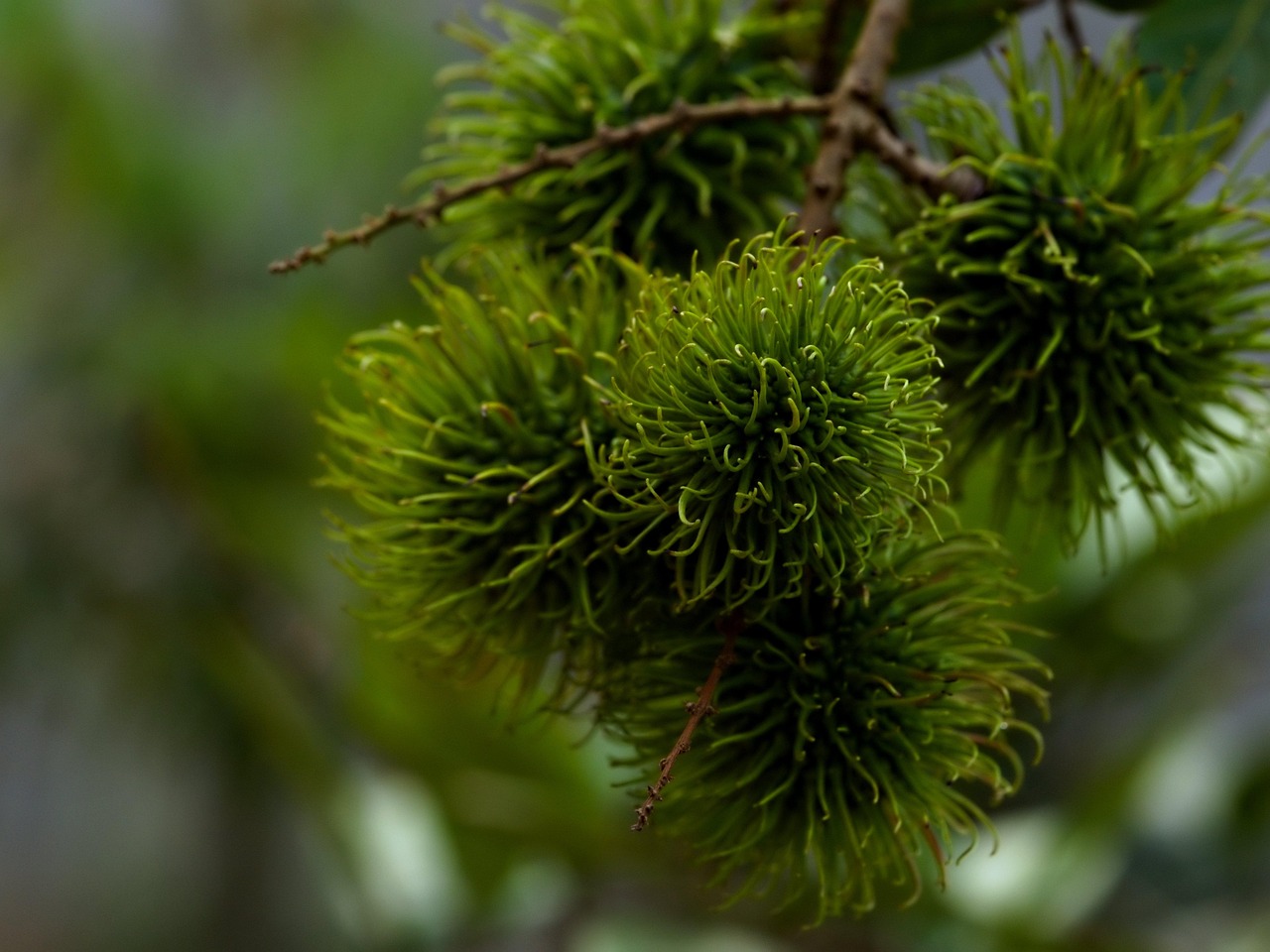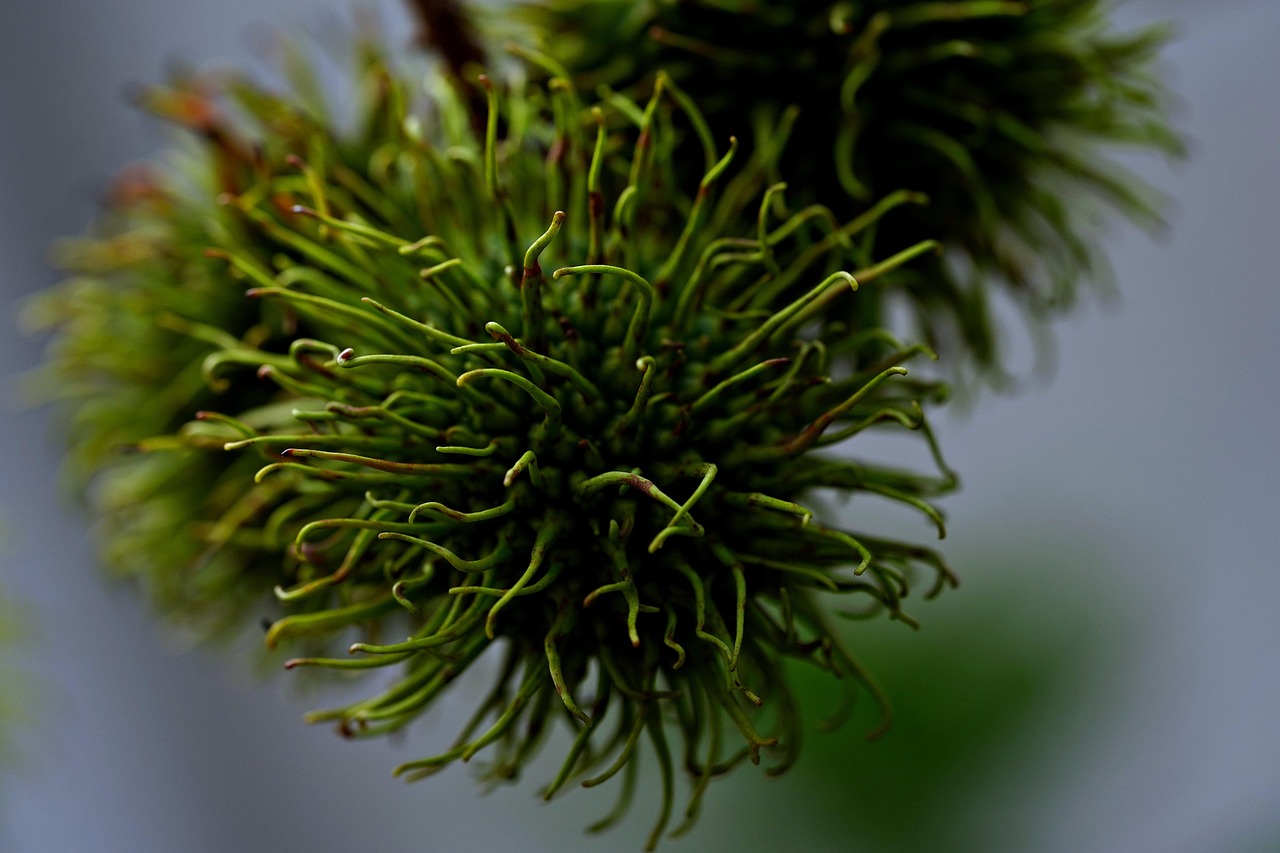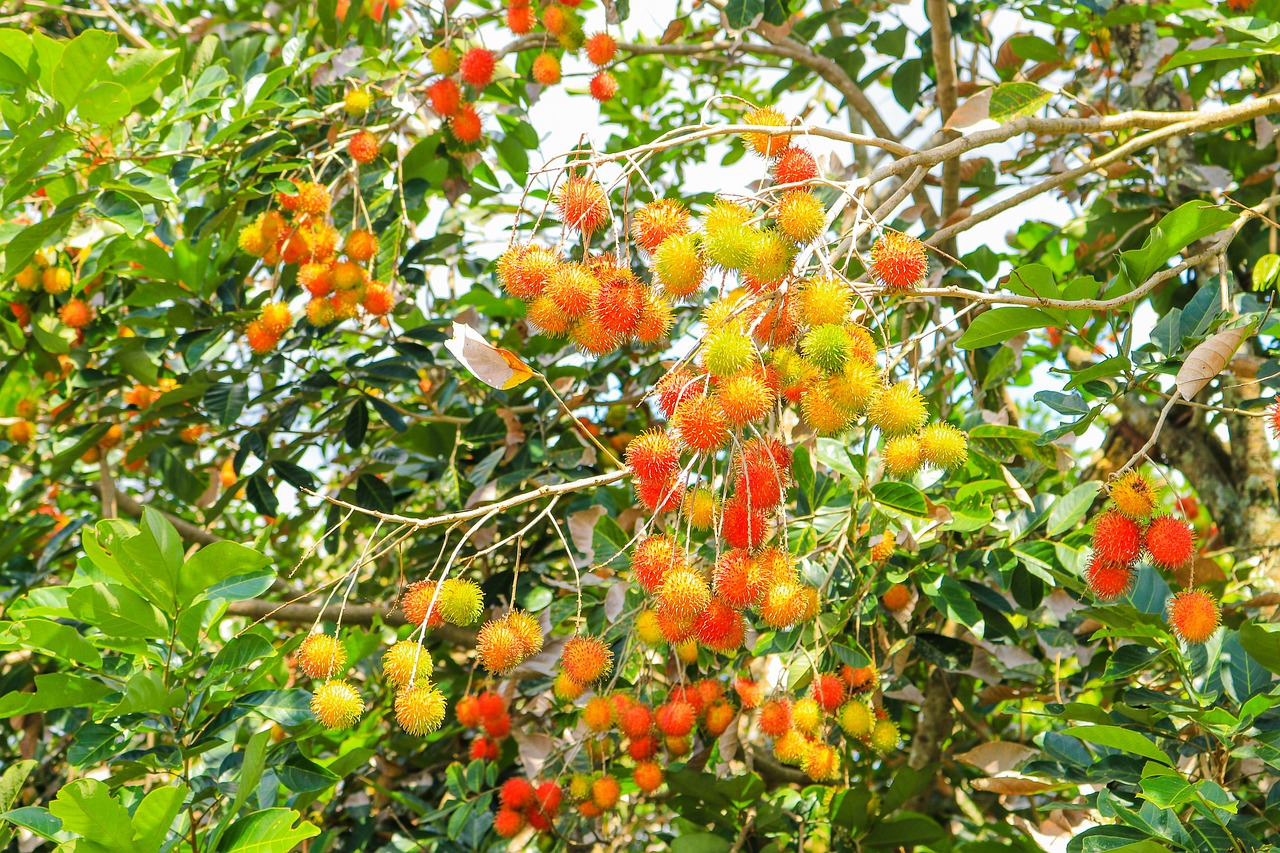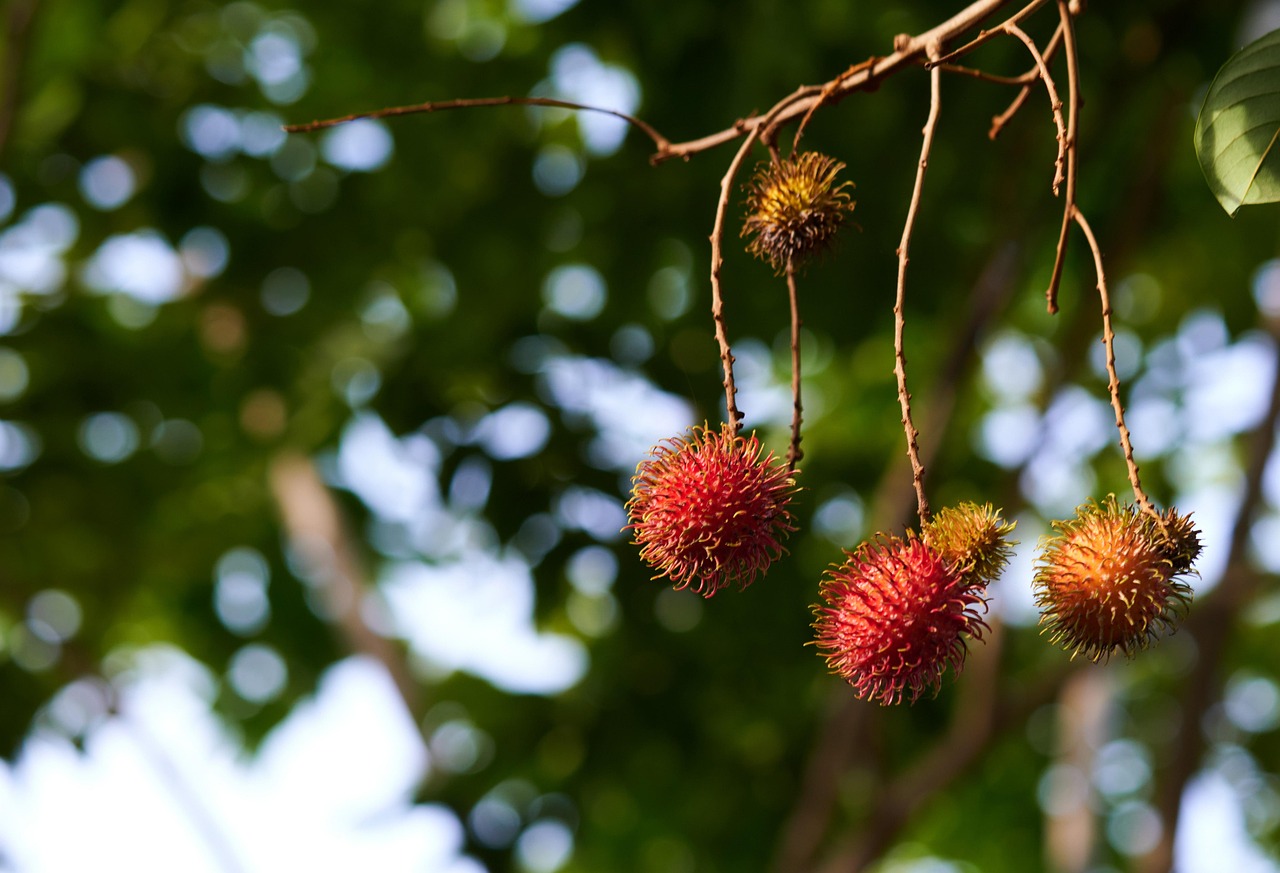The rambutan tree (Nephelium lappaceum) exhibits a moderate growth rate, typically reaching 10 to 20 feet in height within five to seven years under optimal conditions in Southeast Asian orchards. This growth depends on factors like soil quality, climate, and care practices.
Rambutan is a tropical fruit tree native to Southeast Asia. It is highly valued for its juicy, sweet, and aromatic fruits, which have gained popularity worldwide. The rambutan tree thrives in humid, tropical climates, making Southeast Asia an ideal region for its cultivation. Countries such as Indonesia, Malaysia, Thailand, and the Philippines are known for their extensive rambutan orchards. The cultivation of this tree not only contributes to local economies but also adds biodiversity to the region.

The growth rate of rambutan trees can vary significantly based on several environmental and management factors. To understand how these trees flourish, it is vital to consider aspects like soil type, irrigation practices, and fertilization methods. Each of these factors plays a crucial role in determining the health and productivity of the trees.
Factors Influencing Growth Rate
Several factors affect the growth rate of rambutan trees. Below are the key influences:
- Soil Quality: Rambutan trees prefer well-drained, sandy loam soils rich in organic matter. Poor soil conditions can stunt growth.
- Climate: A consistently warm climate with high humidity is essential for optimal growth. Temperatures between 77°F to 95°F (25°C to 35°C) are ideal.
- Irrigation: Adequate water supply is crucial. While rambutan trees are somewhat drought-tolerant, insufficient water can reduce growth rates and fruit yield.
- Fertilization: Regular application of balanced fertilizers enhances growth. Nutrient deficiencies can lead to poor health and slow growth.
- Pest and Disease Management: Effective control of pests and diseases is essential to maintain healthy trees and ensure steady growth.
It is important for farmers to implement best practices in orchard management to maximize the growth potential of rambutan trees. Understanding these factors allows growers to create a conducive environment that promotes healthy growth and high fruit production.

Growth Stages of Rambutan Trees
Rambutan trees undergo several distinct growth stages from planting to maturity. Each stage has its specific requirements and characteristics:
- Seed Germination: Seeds typically take about two weeks to germinate under favorable conditions.
- Young Tree Development: From germination until about three years, the tree focuses on establishing roots and foliage. This stage is critical for future growth.
- Mature Tree Phase: After three years, the tree enters its productive phase, starting to bear fruit. Growth during this period can be rapid if conditions are optimal.
- Full Maturity: By five to seven years, rambutan trees reach full maturity, achieving their maximum height and productivity.
This growth cycle highlights the importance of patience and proper care in cultivating rambutan orchards. Farmers must provide the necessary support during each stage to ensure a successful harvest in the long run.
Impact of Environmental Conditions
The environmental conditions in Southeast Asia significantly influence the growth rate of rambutan trees. The region’s tropical climate offers the warmth and humidity that these trees thrive on. However, variations in rainfall patterns can pose challenges. For instance, excessive rainfall may lead to waterlogging, while prolonged dry spells can stress the trees.

The following table summarizes key environmental conditions conducive to rambutan tree growth:
| Condition | Ideal Range | Effect on Growth |
|---|---|---|
| Temperature | 77°F – 95°F (25°C – 35°C) | Promotes optimal growth and fruiting. |
| Humidity | 70% – 90% | Supports healthy foliage and fruit development. |
| Rainfall | 1000mm – 2500mm annually | Adequate moisture for growth; excess or lack can hinder development. |
Understanding these environmental factors helps farmers make informed decisions about when to plant and how to manage their orchards effectively. Proper management strategies tailored to local conditions can significantly enhance the growth rates of rambutan trees in Southeast Asian orchards.
Rambutan Tree Varieties and Their Growth Characteristics
Different varieties of rambutan trees exhibit varying growth rates, fruit characteristics, and adaptability to environmental conditions. Understanding these differences is crucial for farmers who aim to optimize yield and quality in their orchards. Below are some of the most popular rambutan varieties cultivated in Southeast Asia:
- Binjai: Known for its large, sweet fruits, this variety is highly sought after. Binjai trees can grow rapidly, reaching maturity within five years.
- Rambutan Yellow: This variety is distinguished by its yellow skin when ripe. It typically grows well in humid environments and produces moderate yields.
- Rambutan Lebak Bulus: Popular for its juicy flesh and fragrant aroma, this variety is known for its consistent fruiting patterns.
- Rambutan Rawa: This variety thrives in wet conditions and has a shorter growth cycle compared to others, often bearing fruit within four years.
The choice of variety can significantly influence the overall productivity of the orchard. For instance, some varieties may be more resistant to local pests or diseases, while others may have superior taste and marketability.

Soil Preparation for Rambutan Orchards
Proper soil preparation is essential for establishing healthy rambutan orchards. The following steps can help optimize soil conditions for rambutan tree growth:
- Soil Testing: Conduct a soil test to determine pH, nutrient levels, and organic matter content. Rambutan trees prefer slightly acidic soils with a pH of 5.5 to 6.5.
- Amending Soil: Based on test results, amend the soil with organic matter, such as compost or well-rotted manure, to improve fertility and structure.
- Tillage: Thoroughly till the soil to a depth of at least 12 inches. This helps aerate the soil and promotes root penetration.
- Drainage Considerations: Ensure proper drainage to prevent waterlogging. Raised beds may be beneficial in areas with poor drainage.
These preparation steps create a conducive environment for young rambutan trees, enabling them to establish strong root systems and grow vigorously.
Irrigation Practices for Optimal Growth
Irrigation plays a critical role in the growth of rambutan trees. Maintaining adequate moisture levels is vital, especially during dry periods. Here are some effective irrigation practices:
- Drip Irrigation: This method delivers water directly to the root zone, minimizing water wastage and promoting efficient uptake.
- Mulching: Applying organic mulch around the base of the trees helps retain soil moisture, suppress weeds, and regulate soil temperature.
- Monitoring Soil Moisture: Use soil moisture sensors or simple methods like finger testing to ensure that the soil remains consistently moist but not waterlogged.
By adopting these irrigation practices, farmers can ensure that rambutan trees receive the necessary water for optimal growth throughout their development stages.
Pest and Disease Management Strategies
The health of rambutan trees can be compromised by various pests and diseases. Effective management strategies are essential to mitigate these risks. Here are some common pests and diseases affecting rambutan trees:
| Pest/Disease | Description | Management Strategies |
|---|---|---|
| Fruit Flies | Pests that lay eggs in fruits, leading to decay. | Use traps, remove fallen fruit, and apply organic insecticides if needed. |
| Leaf Spot | A fungal disease causing dark spots on leaves. | Improve air circulation and apply fungicides as required. |
| Scale Insects | Suck sap from leaves and stems, weakening the tree. | Use horticultural oils to control infestations. |
Implementing integrated pest management (IPM) practices can reduce reliance on chemical treatments while promoting a healthier orchard ecosystem. Regular monitoring and timely interventions are key to maintaining tree vitality.
Nutritional Requirements for Healthy Growth
Nutrient management is vital for maximizing the growth rate and fruit yield of rambutan trees. Key nutrients include nitrogen, phosphorus, potassium, calcium, magnesium, and micronutrients. Farmers should consider the following nutritional guidelines:
- Nitrogen: Essential for vegetative growth; apply nitrogen-rich fertilizers during the growing season.
- Phosphorus: Promotes root development and flowering; incorporate phosphorus fertilizers during soil preparation.
- Potassium: Enhances fruit quality and resistance to diseases; apply throughout the growing season.
A balanced fertilization strategy tailored to soil test results will support robust growth and high fruit quality in rambutan trees, ultimately leading to successful harvests in Southeast Asian orchards.
Harvesting Rambutan Fruits
Harvesting rambutan fruits is a critical phase in the cultivation process. The timing and techniques used during harvest significantly affect the quality and quantity of the yield. Rambutan fruits typically mature around 4 to 5 months after flowering. Understanding the key indicators of ripeness is essential for successful harvests.
Indicators of Ripeness
Farmers should look for the following signs to determine when rambutan fruits are ripe for harvest:
- Color Change: Ripe rambutan fruits usually exhibit a vibrant red or yellow color depending on the variety. The skin should be bright and shiny.
- Texture: The spiky exterior should feel firm but slightly yielding when gently pressed.
- Aroma: Ripe rambutan emits a sweet, fruity aroma that is noticeable.
- Firmness of Flesh: When gently squeezed, the flesh should feel soft yet not mushy.
Harvesting at the right time ensures that the fruits are sweet and flavorful, making them more appealing to consumers.
Harvesting Techniques
The method of harvesting rambutan can influence both fruit quality and tree health. Here are some recommended harvesting techniques:
- Hand Harvesting: This is the most common method. Farmers use clippers or scissors to cut the fruit clusters from the tree, taking care not to damage the branches.
- Use of Ladders: In taller trees, sturdy ladders may be necessary to reach higher branches. Safety measures should be taken to prevent falls.
- Avoiding Overripe Fruits: It is essential to pick fruits that are ripe while leaving overripe or unripe fruits on the tree. This helps maintain overall quality and encourages further fruit development.
Proper harvesting methods not only enhance fruit quality but also maintain the health of the tree, promoting better yields in subsequent seasons.
Post-Harvest Handling
Post-harvest handling is crucial for preserving the quality and extending the shelf life of rambutan fruits. The following practices are recommended:
- Immediate Cooling: After harvesting, rambutan fruits should be cooled quickly to reduce respiration rates and maintain freshness. This can be done through refrigeration.
- Gentle Handling: Fruits should be handled carefully to avoid bruising or damaging the skins, as this can lead to rapid spoilage.
- Packing: Use breathable containers to pack rambutan fruits. Styrofoam boxes or perforated plastic bags are often ideal, as they allow air circulation.
- Avoiding Moisture: Keep fruits dry during storage and transportation to prevent fungal growth.
Effective post-harvest management is essential for maintaining market quality and ensuring that consumers receive fresh, delicious rambutan fruits.
Market Demand and Economic Impact
The market demand for rambutan has been on the rise, both locally and internationally. As consumers become more aware of exotic fruits, the popularity of rambutan continues to grow. This increasing demand has a significant impact on the economy of Southeast Asian countries where rambutan is cultivated.
The economic benefits include:
- Increased Income for Farmers: Higher demand leads to better prices for farmers, improving their livelihoods.
- Job Creation: The rambutan industry creates jobs in farming, processing, and distribution sectors.
- Export Opportunities: Countries like Malaysia and Thailand export rambutan to international markets, contributing to foreign exchange earnings.
The growing market for rambutan not only supports local economies but also encourages investment in agricultural practices, leading to improved production techniques and enhanced fruit quality.
Sustainable Practices in Rambutan Cultivation
As demand for rambutan increases, adopting sustainable agricultural practices becomes important. These practices help ensure long-term productivity while protecting the environment. Key sustainable practices include:
- Organic Fertilizers: Utilizing organic compost and biofertilizers reduces chemical usage, promoting environmental health.
- Pest Management: Implementing integrated pest management (IPM) techniques minimizes chemical pesticide use while effectively managing pest populations.
- Diversity in Planting: Incorporating biodiversity by planting other crops alongside rambutan can improve soil health and reduce pest outbreaks.
Sustainable practices not only benefit the environment but also enhance the resilience of rambutan orchards, ensuring consistent yields in changing climatic conditions.
Challenges in Rambutan Cultivation
Despite the numerous benefits and increasing demand for rambutan, several challenges can impact its growth and productivity. Farmers need to be aware of these challenges to implement effective solutions. Here are some common issues faced in rambutan cultivation:
- Climate Variability: Changes in weather patterns, such as unexpected droughts or excessive rainfall, can disrupt growth cycles and affect fruit quality.
- Pest Infestations: Pests like fruit flies and scale insects can significantly reduce yields. Continuous monitoring and management are necessary to minimize their impact.
- Diseases: Fungal infections and root diseases can hamper tree health. Regular inspections and preventive measures are essential to maintain orchard vitality.
- Market Fluctuations: Prices for rambutan can vary due to supply and demand dynamics, affecting farmers’ income stability.
Addressing these challenges requires a combination of knowledge, proper management practices, and community support. Farmers who stay informed about best practices are more likely to succeed in overcoming these obstacles.
The Role of Technology in Rambutan Cultivation
Advancements in agricultural technology play a significant role in enhancing rambutan tree growth and productivity. The integration of modern technology can lead to more efficient farming practices. Some technological innovations include:
- Precision Agriculture: Utilizing GPS and remote sensing technologies allows farmers to monitor soil conditions, moisture levels, and crop health more accurately.
- Mobile Applications: Various apps provide farmers with information on weather forecasts, pest management, and market prices, helping them make informed decisions.
- Automated Irrigation Systems: Smart irrigation systems can optimize water usage by providing the right amount of water based on real-time data, ensuring healthier tree growth.
By adopting these technologies, farmers can enhance their operational efficiency and increase the overall productivity of their rambutan orchards, leading to better economic outcomes.
Community Support and Education
The success of rambutan cultivation also relies on community support and education. Local agricultural extension services can provide valuable resources to farmers. Workshops, training sessions, and informational resources help farmers understand best practices for growing rambutan trees.
- Knowledge Sharing: Farmers can benefit from sharing experiences and techniques with one another, forming a supportive network that fosters collaboration.
- Access to Resources: Educational programs can help farmers access tools, seeds, and organic fertilizers that promote sustainable practices.
- Market Access: Community initiatives can assist farmers in finding markets for their produce, ensuring they receive fair prices for their fruits.
A strong community network can empower farmers to adapt to changes, overcome challenges, and ultimately thrive in the rambutan market.
Final Thoughts
The growth rate of rambutan trees in Southeast Asian orchards is influenced by various factors including soil quality, climate conditions, and farming practices. As demand for this tropical fruit continues to rise, it is essential for farmers to implement effective management strategies that encompass sustainable practices, technological advancements, and community support. By addressing challenges such as pests, diseases, and market fluctuations, growers can optimize their yields and contribute positively to local economies.
Moreover, understanding the unique characteristics of different rambutan varieties allows farmers to select the best options for their specific environmental conditions. With proper care, rambutan trees can not only thrive but also offer significant economic benefits to growers in Southeast Asia. The future of rambutan cultivation looks promising as long as farmers remain proactive in adopting innovative practices and collaborating with their communities.
